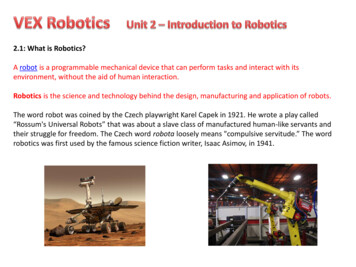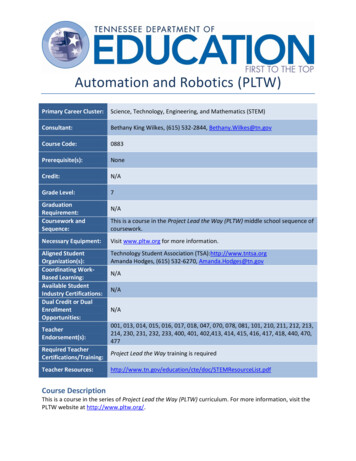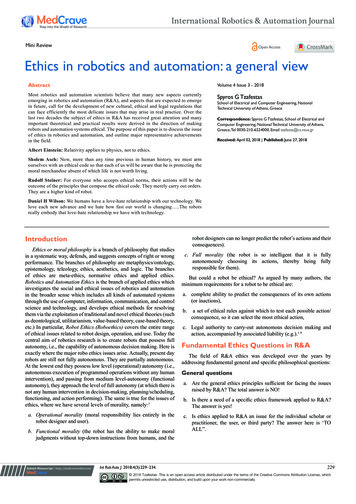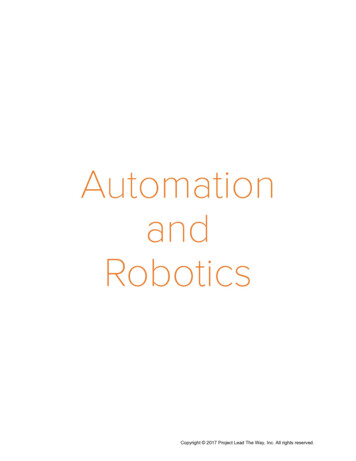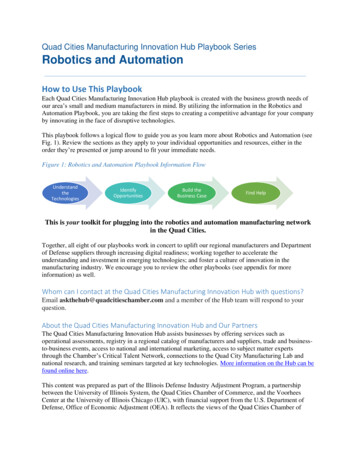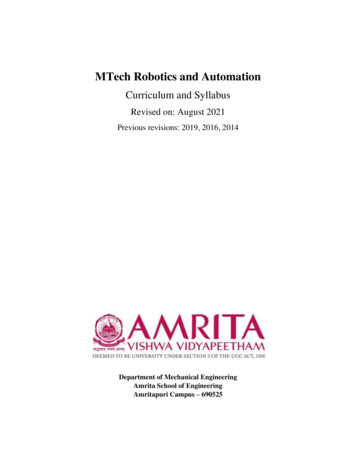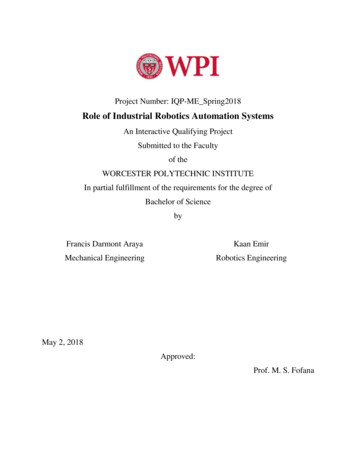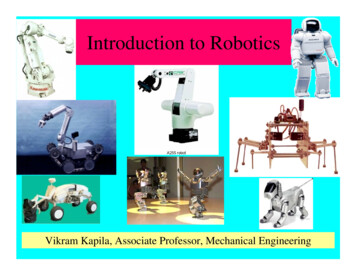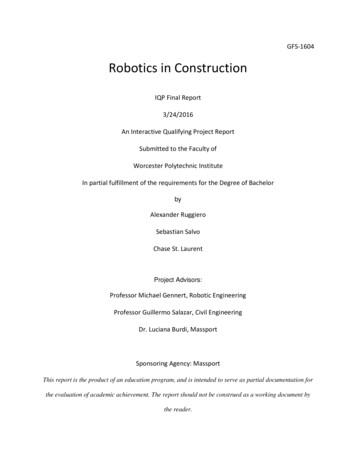
Transcription
GFS-1604Robotics in ConstructionIQP Final Report3/24/2016An Interactive Qualifying Project ReportSubmitted to the Faculty ofWorcester Polytechnic InstituteIn partial fulfillment of the requirements for the Degree of BachelorbyAlexander RuggieroSebastian SalvoChase St. LaurentProject Advisors:Professor Michael Gennert, Robotic EngineeringProfessor Guillermo Salazar, Civil EngineeringDr. Luciana Burdi, MassportSponsoring Agency: MassportThis report is the product of an education program, and is intended to serve as partial documentation forthe evaluation of academic achievement. The report should not be construed as a working document bythe reader.
AbstractThis project reviews construction process and new emerging robotic technologies, allwhile keeping in mind the societal implications the new technologies may have. The studyidentifies and analyzes the benefits and limitations of a wide array of robotic applications. Aroadmap and timeline are created to guide Massport on how and when to implement thevarious robotic applications into their construction operations. The end result of this projectcould be extended to the construction industry as a whole.ii P a g e
AcknowledgementsThe authors would like to thank the following individuals for their contributions and assistancethroughout the duration of this project:Dr. Michael SchroederDr. Luciana Burdi, MassportDanielle Arciero, MassportMarzia Bolpagni, MassportRuth McKeough, Secretary IRB, WPIProfessor Michael Gennert, Director of Robotics, WPIProfessor Guillermo Salazar, Department of Civil and Environmental Engineering, WPIiii P a g e
AuthorshipChapter/SectionAuthor(s)AbstractChase St. LaurentAcknowledgementsChase St. LaurentIntroductionAlexander Ruggiero & Sebastiano SalvoBackgroundChase St. LaurentHistory of ConstructionALLMassportALLDevelopment of Construction FacilitiesALLOpportunities for Construction ImprovementALLThe Role of RoboticsALLSocietal IssuesALLMethodologyChase St. LaurentDemolition RobotsChase St. Laurent3D printing & Contour CraftingAlex Ruggiero & Chase St. LaurentDronesALLBricklaying RobotsAlex Ruggiero & Chase St. LaurentWelding RobotsAlex Ruggiero & Chase St. LaurentExoskeletonsSebastiano Salvo & Chase St. LaurentForklift RobotsChase St. LaurentRoadwork RobotsAlex Ruggiero & Chase St. LaurentFuture Tech: HumanoidsSebastiano Salvo & Chase St. LaurentTimeline to AvailabilityChase St. LaurentResearcher Ranking AnalysisChase St. LaurentConstructionChase St. LaurentSocial ImplicationsChase St. LaurentRisk AnalysisChase St. LaurentCost Benefit AnalysisALLFinal Rubric GradesChase St. LaurentConclusionChase St. Laurentiv P a g e
Table of ContentsAbstract. iiAcknowledgements . iiiAuthorship. ivTable of Contents. vList of Figures . viiList of Tables . ix1.0 Introduction . 12.0 Background . 32.1 Evolution of Construction . 32.2 Massport . 42.3 Development of Constructed Facilities . 42.4 Opportunities for Construction Improvement . 52.5 The Role of Robotics. 62.6 Social Issues . 73.0 Methodology . 94.0 Research and Results: Robotic Technologies .134.1 Demolition Robots .134.2 3D Printing and Contour Crafting .174.3 Drones .184.4 Bricklaying Robots.234.5 Welding Robots .254.6 Exoskeletons .264.7 Forklift Robots .274.8 Roadwork Robots.294.9 Future Technology: Humanoids .304.10 Researcher Ranking Analysis .315.0 Timeline to Commercial Availability .335.1 Timeline Analysis .356.0 Research and Results: Construction and Social Implications .36v Page
6.1 Construction .366.2 Social Implications .376.2.1 Community Survey .376.2.2 Construction Worker Survey .407.0 Research and Results: Risk and Cost Benefit Analysis .497.1 Risk Analysis .497.2 Cost Benefit Analysis .518.0 Research and Results: Final Rubric Grades.549.0 Conclusion .61References .63Appendix A: Return on Investment .67Appendix B: List of Research Questions .68Appendix C: Portfolio .72vi P a g e
List of FiguresFigure 1: Flowchart of MethodologyPage 10Figure 2: Multi-Tooled Demolition RobotPage 14Figure 3: Hydro-Powered Demolition RobotPage 15Figure 4: Eco-Friendly Demolition RobotPage 16Figure 5: 3D Printing RobotPage 17Figure 6: Contour Crafting DronePage 19Figure 7: Swarm of DronesPage 20Figure 8: Transportation DronePage 20Figure 9: Surveying DronePage 21Figure 10: Monitoring DronePage 22Figure 11: Bricklaying Robots: WallsPage 23Figure 12: Bricklaying Robots: RoadsPage 24Figure 13: Welding RobotPage 25Figure 14: Exoskeleton SuitPage 27Figure 15: Forklift RobotPage 28Figure 16: Repaving RobotPage 29Figure 17: Repainting RobotPage 29Figure 18: Humanoid RobotPage 30vii P a g e
Figure 19: Timeline to Commercial AvailabilityPage 34Figure 20: Community Survey: TimelinessPage 39Figure 21: Community Survey: PrivacyPage 39Figure 22: Community Survey: SafetyPage 40Figure 23: Construction Worker Survey: Job SecurityPage 41Figure 24: Construction Worker Survey: ProductivityPage 43Figure 25: Construction Worker Survey: SafetyPage 44Figure 26: Construction Worker Survey: SecurityPage 45Figure 27: Construction Worker Survey: QualityPage 46Figure 28: Construction Worker Survey: Learning MaintenancePage 46Figure 29: Construction Worker Survey: AssistancePage 47Figure 30: Construction Worker Survey: CooperationPage 48Figure 31: Cost Benefit EquationPage 51Figure 32: Robotic Grading SheetPage 56Figure 33: Robot Ranks Part 1Page 57Figure 34: Robot Ranks Part 2Page 58Figure 35: Portfolio ExamplePage 60viii P a g e
List of TablesTable 1: List of Secondary QuestionsPage 67Table 2: Researcher RatingsPage 32Table 3: Availability RatingPage 35Table 4: Community Survey ResultsPage 38Table 5: Construction Worker Survey ResultsPage 42Table 6: Risk AnalysisPage 50Table 7: Cost Benefit ResultsPage 51Table 8: Final Grade RubricPage 54Table 9: Final Robot GradesPage 55ix P a g e
1.0 IntroductionThis study explores how robotics is being used, and could be used in the future, in thefield of construction. Robotics as a whole is a synchronous combination of mechanical,electrical, and software engineering. It is a field that aims to better the lives of humans in tasksthat are dangerous, dirty, or demanding. Construction is the process of creating or renovating abuilding or an infrastructure facility.Due to the evolving field of robotics, the goal of this project is to find out how roboticscan be implemented into construction tasks and to identify as many robotics technologies aspossible that can have some application in construction, while also determining if any of thesepotential technologies can be integrated in the near future. This could potentially facilitatemany construction processes to make them safer for workers, take up less time, or even toperform simple tedious tasks.The project is sponsored by the Massachusetts Port Authority (Massport) who isexploring the potential integration of robotics to benefit their construction projects in theupcoming years.This project reviews construction process and new emerging robotic technologies, allwhile keeping in mind the societal implications the new technologies may have. The studyidentifies and analyzes the benefits and limitations of a wide array of robotic applications. Aroadmap and timeline are created to guide Massport on how and when to implement thevarious robotic applications into their construction operations. The end result of this projectcould be extended to the construction industry as a whole.1 Page
The research was conducted through an extensive review of robotics technology andthrough two online surveys distributed to construction workers and other individuals notdirectly involved in construction. A methodology was developed to assess the benefits andlimitations of each technology.2 Page
2.0 BackgroundThis chapter serves as a summary of multiple concepts necessary to fully understand thescope and underlying factors involving the projects necessity and requirements. In the followingsections we describe the construction industry, the possibility of improvement in theconstruction industry, the role robotics may play in that improvement, and the societalimplications robotics present.2.1 Evolution of ConstructionConstruction has been prevalent since the dawn of mankind. From the pyramids ofEgypt and the Great wall in China to the latest projects such as modern bridges andarchitecture. Construction has been a human endeavor for generations in all parts of the globe.These projects took extensive amounts of time to build and demanded large use of resourcesincluding labor. Some of this was slave labor, many of whom died in the course of building theproject. The contemporary construction methods of the modern world have seen a vastimprovement. Today there are machines and tools to assist labor in accomplishing tasks thatwould have taken significantly more time in ancient times. With the introduction of newmaterials, steel and concrete, the construction industry has also seen vast improvements.Concrete is a relatively low cost, structural material. It is strong and durable, and is widely usedfor virtually any type of project around the world. Steel provides needed strength forsupporting the loads of large scale buildings in a more efficient way (“Construction IndustryHistory”, 2010). In addition, there are also regulations put into place to harbor safer working3 Page
conditions, thanks in part to the Occupational Safety and Health Administration, or OSHA(“OSHA”, 2015).2.2 MassportMassport is “a world class organization moving people and goods - and connectingMassachusetts and New England to the world - safely and securely and with a commitment toour neighboring communities” (“Massport - Mission”, 2015). This mission statement clearlydefines their intentions to become a global gate for transportation of people and goods. Theiraim is to improve and modernize the facilities they have created and give them the bestamenities for improved best customer service. Their projects include Boston Logan Airport,Worcester Airport, and the Port of Boston to name a few. There are also countless otherconstruction projects involving facility creation, taxiway creation, and countless more projects.With many diverse projects being maintained and future projects, construction never ends forMassport (“Massport - Home”, 2015). Massport wants to improve and modernize theirconstruction process through the use of technology, particularly through the advancement andtransition to robotic technologies.2.3 Development of Constructed FacilitiesWhether it be modern times or ancient times, construction starts with an idea for astructure. Whether it be for a house or a skyscraper, there must be a need for a structure.Once the idea is formulated, architects are given the task of designing the structure, fleshingthe idea out into specifics such as quality, functionality, and workmanship. Once specifics are4 Page
defined in terms of drawings and specifications a builder is called upon to erect the designedfacility. This turns the design into a finished built product. The entire process is coordinated bya project manager in charge of securing all required resources to complete the project on-time,on budget, and according to the designer specific quality. The project manager is also in chargeof finding and enlisting contractors for the construction project. Once finances and contractsare in order, construction begins. The project follows a defined timetable and finances areconstantly monitored throughout the duration of the project. The construction process issequential and many tasks are done throughout the entirety of the process from start to finish(“Construction Process”, 2015).2.4 Opportunities for Construction ImprovementThe rate at which construction progresses is subject to variability. Productivity dependson many variables including the weather and worker productivity which depends on factorssuch as overtime, morale and attitude, fatigue, stacking of trades, mobilizing and demobilizing,general errors, reassignment of manpower, crew size inefficiency, hazardous work areas, andthe list goes on ("Factors Affecting Construction Labor Productivity", 2012). A commonunderlying factor to this variability is natural human imperfection. Another issue seen in theconstruction industry is security. Security has been a rising issue at many construction sites.One primary example is thieves have been stealing copper pipes during the night. Even theworkers themselves may be pilfering materials from the construction site for their ownpersonal gain ("Why Construction Surveillance is so Important", 2015). A need for enhancedsecurity is necessary for construction managers and industries as a whole to operate smoothly5 Page
without any hindrance or disappearing materials. Another primary issue seen at constructionsites is the safety of workers. Although OSHA has helped in keeping the number of injuries anddeath tolls down, safety is still a large issue today in construction. Over the past summer, anironworker working on the new Logan Airport parking garage was trying to secure a concretepanel when the panel fell from the crane and caused him to plummet 40 feet. He was sent tothe General Hospital where we succumbed to his injuries (Crimaldi, 2015). Clearly safety on aconstruction site is most crucial, and steps should be made to further increase the safety at thejob sites.2.5 The Role of RoboticsWith traditional issues surrounding the construction industry, there is alwaysopportunity for improvement and robotics engineering plays an important role in it. “Roboticsis the science of designing, building, and applying robots. Robotics is a solid discipline of studythat incorporates the background, knowledge, and creativity of mechanical, electrical,computer, industrial, and manufacturing engineering” (Jackson, 2015). Robots, in general, havemany advantages and benefits. Some of these benefits are an improved production quality, andan improved quality of life for workers in any industry (Jackson, 2015). For example, robots canhave microscopic precision and produce quality in products otherwise not possible to achievewith traditional labor skills. Robots can also be used in areas that are hazardous to humans.Many of the emerging robotic technologies today that can be applied to constructionapplications are demolition robots, 3D printing robots, robotic drones, bricklaying robots,welding robots, exoskeletons, forklift robots, and roadwork robots. All of these robotic6 Page
technologies have the potential to improve many construction industry areas such asproductivity, quality, security, safety, and can even stimulate the creation of more jobs. Robotsalso come with their own respective negative aspects. There are also many future technologieswhich could further enhance the construction industry including humanoids and mobiletelepresence robots. All of these technologies are further discussed in this study in more detail.2.6 Social IssuesThere are many social issues to take into account when discussing robotic applications inconstruction. One of these concerns comes in the form of privacy, both worker and publicprivacy. Any surveillance technologies are examples of potential invasions of privacy whenusing robotic technologies. Another main issue is the fear of job loss. One big fear for the rise ofrobotics is that workers may lose their jobs to a machine. They do not want an automatedrobot to do the job they, as a human, are paid to do (Romeo, 2015). The robots make the jobeasier and potentially lower costs of production since they are not necessarily subject tonegotiation of hourly wages. A robot is a one-time investment that will pay for itself over time.With a robot there are no unions to worry about, no healthcare costs, just maintenance costs.This job substitution could also be seen as a good thing. Instead of humans being in charge ofthe simpler jobs that robots can do, they could potentially be hired to perform maintenancechecks on the robots instead. With the rise of robotics comes the rise of those with knowledgein robotics to work on them. Another societal issue is the concern of safety. While we do nothave to worry about a science-fiction robot apocalypse scenario where robots become moreintelligent than their creators, there can be a concern with their programming. For most robots,7 Page
their program is procedural. If a random event occurs, such as a worker walking in its path, therobot may not be prepared for that. In this case, safety protocols would need to be placed toprotect those around the robot’s work envelope (“Industrial Robots and Robot System Safety”,2015). Another societal issue is hacking of the robotic systems or hijacking them. Cybercrimeshave evolved along with computer technology. Robots can be hacked either directly orindirectly. Indirectly, a hacker can infiltrate a robot similarly to hacking a website. Drones canbe hacked on their Bluetooth communication network (“Burke, 2015). The fear of technology aswell as change are topics that easily tie together with the fear of job loss the public has withrobotics being used in the current job market. A large portion of robotics movies are alsothemed around the fear of change and how the world changes due to the introduction ofrobots into society. Most are quite negative, as that makes for more entertaining storyline,taking a movie such as, “I, Robot”, as an example. The movie is about robots working withhumans in society until a new version of robot comes out that gets a virus and tries to take overthe world (“I, Robot”, 2004). This is a fear many people experience and what they see about thefuture of robotics.8 Page
3.0 MethodologyThe procedure to conduct this project is a multi-step process with many iterations. Thischapter outlines the strategy and process followed in order to attain the project goals and toachieve the desired outcomes. It provides a guide to how the goal was met, what objectiveswere attained, what methods were used to complete the objectives, and finally how thoseobjectives accomplish the project goal. Figure 1 shows, graphically, the flow and components ofthis process.The research strategy is based on the posing of key questions aimed at answering thefocus question of the project: “How can robotic technologies be used to benefit theconstruction industry of Massport and the surrounding communities?”In order to answer the focus question, many secondary questions were formulated andanswered by gaining knowledge through research along the way and collecting data as needed.Appendix B shows the various list of questions that were formulated. Each week, two or threeof these questions were answered through various research methods. The secondary questionshave the following distinct categories: the construction process, Massport, robotictechnologies, and the workers and surrounding communities. Work between team memberswas divided equally and each member worked on individual research for every sub-question.Once collected, the team congregated and compiled all the gathered information.9 Page
Figure 1 - Flowchart of Methodology10 P a g e
In order to answer the secondary questions, data was generated from methods such asonline research, using polling software to poll construction workers and communities. Thesemethods were used to collect the relevant data for opinions of workers, robotic technologiesthat are readily available and those to come in the future, the construction process, as well asdata on past, present, and future Massport projects.Once the critical data was collected, analysis was conducted. The information that wasgathered from the workers opinions was analyzed using polling charts on a Likert type scale.SurveyMonkey software was used to gather these charts and needed data. This data was thenorganized and analyzed. It contains the opinions of the workers on various subjects regardingthe integration of robotics into the workforce.Each robotic technology was analyzed to determine how they could be used, their prosand cons, how they could be integrated into construction, and at what cost. Using a gradingrubric, each potential robotic technology category was graded out of 100% and assigned agrade based upon its results on key factors that determine its success such as availability, riskanalysis results, cost benefit results, responses from both the community and constructionworker surveys, and lastly on the opinions of the researchers. Using this rubric, these analyseswere sorted into distinct categories based on where and how they can most directly assist theconstruction process. These categories were formatted based off of the CSI masterformat.Once the analysis was completed for all four categories, the next task was to synthesizeall of it to create a roadmap. This roadmap served as suggestions for integration of eachresearched robotic technology into construction. The roadmap was a deliverable for Massport11 P a g e
that would assist them with decision making on how to proceed if they choose to involverobotics in their processes. Another deliverable for Massport, in conjunction with the roadmap,was a timeline that allows one to know when each individual robotic technology is estimated tobe commercially available, if not already available. The timeline was a separate deliverable, butworked in conjunction with the roadmap. The timeline assisted them with planning theintegration process. Once all of the previous steps (data collection, data analysis, synthesizingof analysis, deliverable creation) were accomplished, the last step, yet developed as progresswas made on the project during its entirety, was to generate a final report on the outcomes ofthis IQP. Once this document was created, the roadmap and timeline was presented in acumulative portfolio and Massport was given a final presentation about our entire researchprocess, concluding the IQP, Robotics in Construction.12 P a g e
4.0 Research and Results: Robotic TechnologiesOur research investigated three main areas: Robotic technology, construction processesand its trends, and lastly the social implications of robotic integration. This first section of ourresearch and results focuses on the robotic technologies studied in this project. To fullyresearch these technologies we looked at their applicability, their pros, cons and limitations,and their availability. Many of the emerging robotic technologies today that can be applied toconstruction applications are demolition robots, 3D printing robots, robotic drones, bricklayingrobots, welding robots, exoskeletons, forklift robots, roadwork robots, and humanoids. All ofthese robotic technologies have the potential to solve many current issues affecting theconstruction industry but some still have negative aspects.4.1 Demolition RobotsDemolition robots are primarily used for tearing down building walls and other variousstructures. Demolition is an important part of construction, specifically in the renovation field.In a case where a floor of a building needs to be redesigned, demolition occurs to toppleexisting walls in order to give room to create a new layout. The primary benefits of demolitionrobots are that they are much more effective than handheld equipment. They also allow theoperator to stand away from the debris and contaminants, making them safer than handhelddevices. A key note here is that current versions of demolition robots are primarily designed forsmall scale demolition, not large scale applications. Some demolition robots use hydropower tobring down materials such as weak concrete and can prevent the air from being polluted withmaterial dust. Some of the negative aspects of demolition robots from the social point of view13 P a g e
is that it could require less workers for the typical demolition job, leading to job loss (“RemoteDemolition”, 2015).There are three distinct types of demolition robots that are available or beingdeveloped: multi-tooled, hydro-powered, and eco-friendly. Multi-tooled demolition robotsallow for multiple types of tools to be placed at the end of a robotic arm on the demolitionrobot. Figure 2 shows a multi-tooled demolition robot:Figure 2 – Multi-Tooled Demolition RobotHydro-powered demolition robots use high pressured water jets to disintegrate wallsand beams with ease. Figure 3 shows a hydro-powered demolition robot:THIS SPACE HAS BEEN INTENTIONALLY LEFT BLANK14 P a g e
Figure 3 – Hydro-Powered Demolition RobotEco-friendly demolition robots aim to function similarly as hydro-powered demolitionrobots, but also absorb the material they remove and process it to make the materialrecyclable. Figure 4 shows an eco-friendly demolition robot:THIS SPACE HAS BEEN INTENTIONALLY LEFT BLANK15 P a g e
Figure 4 – Eco-Friendly Demolition RobotOne key positive aspect is that they only require one operator no matter the type ofdemolition robot. They all allow for the safety of demolition workers to be significantlyincreased by keeping only one worker at bay behind a controller. The hydro-powereddemolition robots also prevent dust particles from getting into the local atmosphere. The ecofriendly demolition robots turn the waste product into recyclable aggregate. All types ofdemolition robots save money, as an investment, as they reduce the number of workersrequired which is discussed later on in this report. The major negative aspect of demolitionrobots is that they all require a significant power source to operate, whether it be a battery or acord to an industrial grade outlet or generator.16 P a
Mar 24, 2016 · This study explores how robotics is being used, and could be used in the future, in the field of construction. Robotics as a whole is a synchronous combination of mechanical, electrical, and software engineering. It is a field that aims to better the lives of
